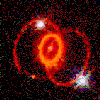|
The atoms involved in our everyday life are not too energetic. Take the air
we breathe: its molecules have energies around 0.03 ev (electron volt--see
energetic particles) as fast as a cannonball, though still quite a bit slower than the typical satellite. Such
molecules bounce off each other like billiard balls, lacking the force to
affect each other's structure by, say, tearing off electrons.
The Sun's plasma is much hotter, and that of the magnetosphere is still hotter. Auroral electrons typically have 1000 to 10,000 ev, as do protons in the magnetotail. Ring current protons reach higher, around 20,000 to 100,000 ev, while inner belt protons go higher still, typically 10,000,000 to 100,000,000 ev. In a nutshell, the magnetosphere is a high-energy environment, where speeds amounting to 1/10 the speed of light are not uncommon.
How unusual is this? How does the rest of the universe compare? Are the
high-energy ions and electrons of the magnetosphere an exceptional and rare
population?
The unexpected answer is that even higher energies seem quite commonplace in the universe. One piece of evidence is a rain of fast ions constantly bombarding Earth, coming from distant space and much more energetic than any found in the magnetosphere. They are known as cosmic rays or cosmic radiation.
Cosmic Rays and Starlight
Individually the cosmic ray ions are much faster and more energetic than
those trapped in the Earth's field, though their overall number is rather small. The radiation is therefore not intense, giving us about as much energy as
starlight. That does not sound like much, until one remembers what the stars are--distant suns, about a hundred billion of them traveling together in our galaxy, and untold billions in more distant galaxies. "As intense as starlight" seems to say that our galaxy gives about as much energy to exotic particles moving close to the speed of light, as it gives to the visible light of its billions of stars.
Actually, the source of cosmic rays is probably not quite as intense, because
cosmic ray particles can stay around the galaxy much longer than starlight.
Starlight moves in straight lines, one pass through our galaxy and it is
gone, into the great emptiness between galaxies. This may require (say) 5000-
50,000 years, going through a thickness of as many light years. Cosmic ray
ions, on the other hand, may be trapped by weak magnetic fields in the
galaxy--trapped not forever, because sooner or later they hit an atom of the
rarefied gas which fills the void between stars, but for a period of the order of 10 million years.
If cosmic ray ions stay around (on the average) 1000 times longer than
starlight, their source only needs 1/1000 of the energy output of the stars to match the
intensity of starlight. But even 1/1000 of the energy of starlight is still an
enormous amount! If the Sun had invested 1/1000 of its energy input in
cosmic radiation, the radiation level around it would have been sufficient to snuff out any life emerging on Earth.
What are they?
What sort of particles are these? On the ground one rarely encounters the
"primary" cosmic rays, because they generally collide high in the atmosphere
and all we get below is a shower of very fast fragments. However, sensitive
photographic plates have been lifted by balloons to the top of the atmosphere,
and have recorded there the passage of "primary" cosmic ray particles. The plates were developed, the tracks were scanned through a microscope, and
by the thickness of those tracks, the particles which had caused them were
identified. This method showed cosmic ray particles to be ions of a familiar
sort--mostly hydrogen, some helium, diminishing amounts of carbon, oxygen
etc. and even a few atoms of iron and of heavier elements, to all intents
proportions similar to those found on the Sun. The conclusion seems to be that
here is ordinary matter, which had undergone some extraordinary process
and had gained huge energies.
Those energies are indeed huge. The atmosphere shields us from cosmic rays
about as effectively as a 13-foot layer of concrete, yet a large
proportion of cosmic ray particles manages to send fragments all the way through it. Some have much, much higher energies, though as one goes up in energy, the numbers drop drastically. Cosmic ray ions at the top of the
energy range produce in the atmosphere showers of many millions of fragments, covering many acres, and their more energetic fragments register
even in deep mines, a mile underground. Relatively few of the particles are so
energetic--an experiment might register them once a week--but their
existence is a real riddle. How can a single atomic nucleus gain such extreme
energies?
Supernovas
To all intents, cosmic rays arrive evenly from all directions in the sky, but
this does not necessarily mean their sources are evenly spread around us.
More likely, they are constantly deflected by magnetic fields in the galaxy,
until any trace of their original motion is lost. In a similar way, sunlight on a
heavily overcast day seems to arrive evenly from the entire sky, and we have
no idea where the Sun actually is, because its light is thoroughly diffused by water droplets in the clouds.
|
 Remnant of Supernova 1987
Remnant of Supernova 1987 Official GSFC Home Page
Official GSFC Home Page  NASA WWW Home Page
NASA WWW Home Page